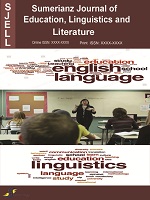Sumerianz Journal of Education, Linguistics and Literature

Online ISSN: 2617-1201
Print ISSN: 2617-1732
Quarterly Published (4 Issues Per Year)
Journal Website: https://www.sumerianz.com/?ic=journal-home&journal=33Archive
Volume 2 Issue 9 (2019)
The Effect of Online Writing on the Syntactic Complexity of EFL Learners’ English Compositions
Authors : Gu Tongqing
Abstract:This paper explores the effect of online writing on the syntactic complexity of EFL learners’ English writing among graduate students. We sampled the initial and final version of 55 English argumentative essays written by Chinese university students on an online writing platform. These essays were analyzed using 14 syntactic complexity measures with the L2 Syntactic Complexity Analyzer (Lu, 2010). Results show that there are significant differences in the use of syntactic structures between the two versions, while there is no significant differences in the 14 measures of syntactic complexity between the initial and final version. The implications of the results for L2 writing teaching and for automatic scoring system are also discussed.
An Application of the “5E’s” Instructional Treatment to Teaching the Concept of Fuzzy Set
Authors : Michael Gr. Voskoglou
Abstract:The fuzzy set theory has been rabidly developed during the last years and has found many and important applications to everyday life, science, technology and equqation. As a result, elements of fuzzy mathematics have been already introduced in the curricula of studies of certain university departments.. In the article at hand the “5 E’s” instructional model is applied for teaching the concept of fuzzy set to university students. This model is based on the principles of social constructivism for learning and has become very popular during the last decades, especially in school education, for teaching mathematics. The outcomes of the qualitative and quantitative analysis of its application for teaching the fuzzy set performed here demonstrate, apart from a very satisfactory student performance, better motivation and deeper understanding of the subject, as well as greater self-efficacy in tackling the corresponding problems with respect to previous cases, where the traditional teacher-centered method had been used.. Therefore, the application of the “5 E’s” model for teaching various other fundamental mathematical concepts at universi8ty level seems to be an interesting and promising area for further empirical research.



